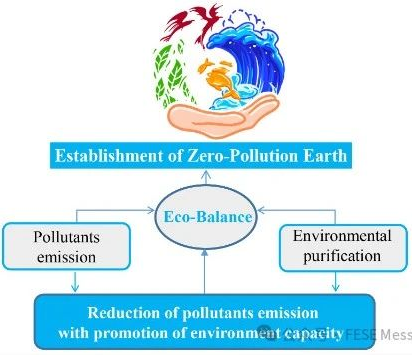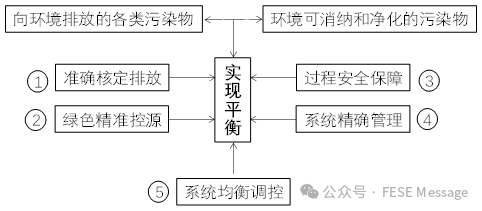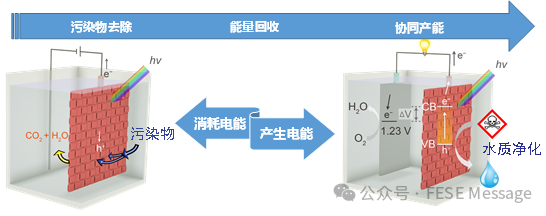The theme of the third United Nations Environment Conference in 2017 was "Building a Zero Pollution Earth". The then Director of the United Nations Environment Programme, Solheim, submitted a report on "Towards a Zero Pollution Earth" to the conference, proposing a comprehensive action framework to combat pollution and setting more than 50 solutions. The consensus formed is that building a pollution-free Earth is of great significance for protecting and restoring resources such as air, water, and food that humans rely on for survival. In 2021, the United Nations Environment Programme released the 2022-2025 Strategy to Address Climate Change, Natural Loss, and Pollution, promoting pollution prevention and control, enabling everyone to ensure good environmental quality and improve health and well-being. At the same time, it is proposed in the "Chemicals and Pollution Action Subplan" that the expected results for 2030 are: "Significant progress towards a zero polluting Earth"; Expected to optimize human health and environmental outcomes by 2025 by strengthening capacity and leadership in the sound management of chemicals and waste; Improved waste management, including through recycling processes, safe recovery of secondary raw materials, and gradual reduction of open-air incineration and dumping sites; The release of pollutants into the air, water, soil, and oceans has decreased. In 2012, the European Green Agreement proposed the "Zero Pollution Action Plan Towards zero pollution for air, water and soil." By 2050, the zero pollution vision is to reduce air, water, and soil pollution to levels no longer considered harmful to health and natural ecosystems, and respect the boundaries that our planet can handle, thereby creating a non-toxic environment; Improve water quality by reducing waste, marine plastic waste (50% reduction), and microplastics released into the environment (30% reduction).

Summary chart
1. Basic understanding of zero pollution
We can understand the so-called "zero pollution" as follows: (1) The discharge of pollutants into the environment and the acceptance of pollutants by environmental media cannot be zero; (2) Pollutants can be discharged, but are controlled below the threshold that causes environmental pollution; (3) The pollutants discharged into the environment are balanced with the pollution load that can be naturally absorbed and purified by the environment. Therefore, the core of zero pollution is the level of environmental absorption of pollutants, that is, achieving a balance between environmental self purification and pollution load. There are two determining factors: the amount and material characteristics of pollutants discharged into the environment, and the ability of the environment and ecosystem to absorb pollution. The balance point between the two is the threshold for pollution control. If we call this equilibrium point T, then if the pollutant emissions are greater than T, pollution effects will occur, and vice versa, pollution effects will not occur.
For this, we need to systematically regulate from all materials, multiple media, all processes, and multiple dimensions, build an environmental protection and governance system that balances pollutant emissions and environmental purification capacity, and achieve the vision of zero pollution. The five necessary factors are: (1) Approved emissions: the quantity and total amount of emissions that can be purified and consumed by the environment; (2) Green source control: achieving the transformation of pollutant energy and resources to minimize their environmental emissions; (3) Process safety: blocking secondary pollution in the governance process, achieving safe transformation and cleaning processes; (4) Precision management: Building a digital environmental management system based on balance theory; (5) System balance: a system balance that controls pollution emissions and the ability of the environment to purify. It can be considered that "balance" is a necessary condition for achieving "zero pollution".

Figure 1: Relationship between the Elements of Balancing Pollutant Emissions and Environmental Consumption
2. The elements and paths towards "zero pollution"
(1) Net emission verification: precise calculation of balance between pollution emissions and environmental self purification capacity
Taking the water environment of a watershed as an example. To accurately evaluate the self-organization, self restoration, and self purification capabilities of water environment and aquatic ecology, and establish a precise accounting method for carrying capacity assessment. To comprehensively and quantitatively evaluate the types, concentrations, environmental metabolic cycles, reaction activity, photothermal and other energy driving mechanisms, emission sources, exposure pathways, and ecological effects of pollutants, establish a standardized evaluation method system to achieve a balance between pollution emissions and consumption, use big data, machine learning and other technologies to achieve precise accounting of complex processes, and develop a decision-making platform for quantitative and precise management. On this basis, accurately evaluate the total amount and component of various pollutants discharged into the environment, determine the level of environmental pollution absorption and its equilibrium point.
(2) Green source control: achieving minimum pollutant emissions through resource and energy conversion
To achieve "zero pollution", it is necessary to maximize scientific and green control of sources. We need to develop clean source control theory and technology to achieve high-value resource utilization and green energy utilization of pollutants. The following two cases demonstrate the comprehensive benefits of achieving pollutant control, utilization, and zero emissions through material recovery and energy conversion pathways.
Case 1: Pollutant removal and synchronous production capacity. Industrial wastewater often contains various pollutants with higher valence states, such as hexavalent chromium. In the water treatment process, it needs to be reduced to a trivalent state, which means it can accept three electrons to become a low valence state. Therefore, high valent chromium is a substance form rich in energy. For this, we can design a water treatment battery system to generate electricity while removing chromium. If assisted by light, synchronous production capacity can be more efficient. The photovoltaic pollution removal capacity system is shown in Figure 2.

Figure 2 Water Treatment Photoelectric Collaborative Pollution Removal Capacity System Diagram
Case 2: China's sewage treatment concept plant achieves resource recovery and energy self-sufficiency. In 2014, six Chinese experts jointly proposed the concept and model of building a Chinese sewage treatment concept plant, and made sustainable water quality, resource recycling, energy self-sufficiency, and environmental friendliness the four pursuits of the concept plant. In December 2018, a primary version of the sewage treatment concept plant with a daily treatment capacity of 40000 m3 was built in Suixian, Henan, achieving high-quality water reuse in rivers and lakes, energy self-sufficiency of over 50%, and organic fertilizer reuse from sludge in farmland. On this basis, the world's first Yixing sewage resource concept plant that perfectly embodies the four pursuits will be built in October 2021, achieving the ultimate removal of key pollutants and high-quality water purification; Utilizing surplus sludge and agricultural waste dry (about 20% dry solids) to collaborate anaerobic digestion and biogas power generation, achieving energy self-sufficiency; Digestive products produce nutrient soil and reuse it in farmland. Urban sewage and industrial wastewater both contain a large amount of valuable substances that can achieve energy conversion and resource recovery. If discharged, it will cause pollution, and if used, it will be beneficial. Therefore, resource and energy recovery and utilization are the top choices towards a zero pollution Earth.
(3) Process safety: blocking secondary pollution and ecological damage during the governance process
The fundamental purpose of environmental governance is to improve ecological quality and achieve ecological integrity. However, in many practical cases of environmental governance, there is no basis or practice for ecological concepts, and systematic investigations and planning are often not carried out. Projects or temporary measures that can temporarily meet environmental indicators are often adopted, and even some engineering measures lead to potential environmental risks and ecological damage. For example, in the treatment of black and odorous water bodies, some places adopt the method of adding chemicals to temporarily clear the water, which leads to external chemical pollution. The implementation of transitional projects causes ecological damage to the water body, and after a large number of projects, the black and odorous water body rebounds. Therefore, water environment governance must be designed according to the goal of ecological restoration, understanding the physical, chemical, and biological characteristics of the water to be treated, using natural based governance methods, and implementing green and ecological restoration strategies. To move towards zero pollution, it is necessary to respect the natural attributes of the environment, reduce the intensity and intensity of human interference, and never add ecological agents to the environment in governance.
(4) Precision Management: Building a Digital Environmental Management System Based on Balance Theory
To achieve precise control of pollutant emissions and environmental purification balance, it is necessary to build a multi-dimensional digital management system. To this end, it is necessary to consider comprehensive control of pollution sources, process pollution control, environmental carrying capacity and self purification capacity, social and economic factors, etc., build a system database, create models that can accurately describe each element, and integrate and optimize the models to form a quantitative, precise, and digital control platform. Based on the actual business needs supporting this platform, we will develop digital software and hardware products that support net emission balance management, such as sensors, detection and communication equipment, simulation and computing products, model-based software, and execution systems. Based on this, we will develop a "net emission balance simulator" to achieve the toolization and platformization of dynamic accounting, regulation, and decision-making of net emission balance, providing precise control technology support for moving towards zero pollution.
(5) System equilibrium: the systematic regulation of pollutant emissions and environmental purification capacity.
The environmental changes and risks caused by pollutant emissions have systematic characteristics. The change of a certain element may have an impact on the whole, and the interaction between elements may amplify the response of the environment and ecosystem. For example, the discharge of sewage into the receiving water body may cause damage to sensitive organisms and their communities, and the interaction between organisms will lead to a decline in the overall health level of the aquatic ecosystem. Therefore, in complex network systems, changes in the state of key nodes and their associated elements may be the cause of systemic changes, or they may be the key factor affecting net emission balance. Therefore, we must study the systematic regulation theory, methods, and implementation paths of net emission balance from the perspective of all materials, all elements, and the entire life cycle, in order to provide scientific basis and technical support for the formulation of zero pollution plans and policies in river basins, regions, cities, and other areas.
3. The Challenge of Moving towards a Zero Pollution Earth
Moving towards zero pollution on Earth is a vision and ideal for humanity to protect and improve the environment and ecology, and an inevitable choice for human survival and development. However, moving towards zero pollution also faces many difficulties and enormous challenges. Our understanding of zero pollution is still preliminary and superficial. Scientific theories, evaluation methods, and implementation paths related to zero pollution have not yet been formed. The environmental, ecological, social, economic, and public foundations for achieving zero pollution are very weak. Pollution control remains the most challenging environmental governance task in China at present. Therefore, in order to move towards a "zero pollution Earth", we must win the battle against environmental protection, moderately and continuously reduce the generation and emissions of pollutants, and achieve a synergistic effect of pollution reduction and carbon reduction; It is necessary to establish and implement a mechanism that highly coordinates and balances the environment and socio-economic factors, develop scientific principles and systematic methods that support net emission balance, and use net emission balance to support the creation of a zero pollution Earth.
The content of this article is from the Perspectives article "Pathways towards a polling free planet and challenges" published in Volume 18, Issue 6, FESE Journal in 2024. The corresponding author is Academician Qu Jiuhui from Tsinghua University.
Post time: May-21-2024

